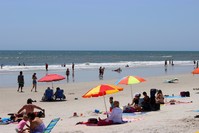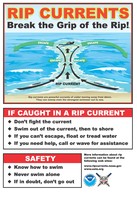

St. Johns County Fire Rescue (SJCFR) officially began full-scale guarded beaches May 28. A team of U.S. Lifesaving Association (USLA) certified beach lifeguards staffed by SJCFR will be on daily assignments from 10 a.m. to 6 p.m. on St. Johns County beaches until Labor Day weekend, the traditional conclusion of beach season.
Lifeguards will staff an average of 18 lifeguard towers. In addition, multiple supervisors patrol the coastline in various response vehicles. Fire personnel housed at coastal stations have been certified as ocean rescue responders and will help supplement the daily beach staffing and emergency response 24 hours a day, according to SJCFR.
The season was off to a busy start over Memorial Day weekend.
SJCFR Public Information Officer Capt. Jeremy Robshaw said SJCFR always anticipates that Memorial Day weekend – when the county traditionally kicks off full-scale beach guarding – is going to be a busy weekend, but this Memorial Day weekend’s intensity was compounded by an increase in surf and rip current activity as a result of the tropical system that was passing the coastline.
On Sunday, May 29 alone, SJCFR lifeguards responded to 18 swimmers in distress, eight medical emergencies, two missing persons and one disabled vehicle – a jet ski.
“The biggest thing is swim near a lifeguard and be informed,” Robshaw said. “When you visit the beaches, pay attention to the flag conditions. If you have questions, please talk to our staff; they are more than happy to provide details as far as the current conditions or any precautions you might need to take as a beachgoer.”
And with the beaches more crowded than ever, he added, it’s important for people to pay attention to the flags and stay safe.
“We’re a growing community, so we have a lot of people coming to this area,” Robshaw said. “The population increase alone is going to create more activity for us from an emergency response standpoint.”
SJCFR beach safety tips
Learn to swim – Learning to swim is the best defense against drowning. Teach children to swim at an early age. Children who are not taught when they are very young tend to avoid swim instruction as they age, probably due to embarrassment. Swimming instruction is a crucial step to protecting children from injury or death.
Swim near a lifeguard – Statistics show that the chance of drowning at a beach without lifeguard protection is nearly five times as great as drowning at a beach with lifeguards.
Never swim alone – Many drownings involve solo swimmers. Swimming with a buddy enables a friend to assist or summon help if one swimmer has a problem. If a swim buddy isn’t available, have someone onshore watching while you swim.
Don’t fight the current – It is estimated that 80 percent of rescues by lifeguards at ocean beaches are caused by rip currents. These currents formed by surf and gravity, because once surf pushes water up the slope of the beach, gravity pulls it back. This can create concentrated rivers of water moving offshore. Some people mistakenly call this an undertow, but there is no undercurrent, just an offshore current. If caught in a rip current, don’t fight it by trying to swim directly to shore. Instead, swim parallel to shore until you feel the current relax, then swim to shore. Most rip currents are narrow and a short swim parallel to shore will bring you to safety.
Swim sober – Alcohol is a major factor in drowning. In fact, it accounts for nearly 60 percent of drowning incidents involving adults. Alcohol can reduce body temperature, impair swimming ability and impair judgment, which may cause people to take risks they would not otherwise take.
For detailed information on rip currents and beach safety, visit www.sjcfl.us/MarineRescue/Safety.aspx or on Facebook at www.facebook.com/sjcfirerescue.